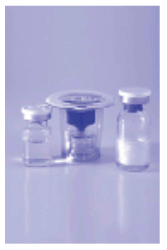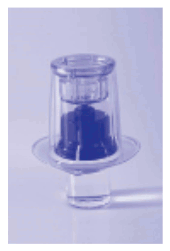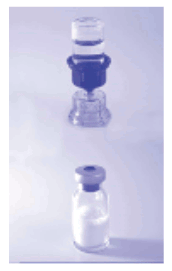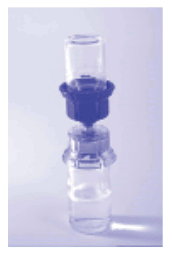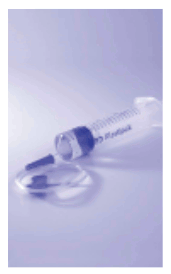OPTIVATE Powder and solvent for solution for injection Ref.[27714] Active ingredients: Coagulation factor VIII
Source: Medicines & Healthcare Products Regulatory Agency (GB) Revision Year: 2020 Publisher: Bio Products Laboratory Limited, Dagger Lane, Elstree, Hertfordshire, WD6 3BX, United Kingdom
4.1. Therapeutic indications
Treatment and prophylaxis of bleeding in patients with haemophilia A (congenital factor VIII deficiency).
Optivate can be used for all age groups.
4.2. Posology and method of administration
Treatment should be under the supervision of a physician experienced in the treatment of haemophilia.
Treatment monitoring
During the course of treatment, appropriate determination of factor VIII levels is advised to guide the dose to be administered and the frequency of repeated infusions. Individual patients may vary in their response to factor VIII, demonstrating different half-lives and recoveries. Dose based on body weight may require adjustment in underweight or overweight patients.
In the case of major surgical interventions in particular, precise monitoring of the substitution therapy by means of coagulation analysis (plasma factor VIII activity) is indispensable.
When using an in vitro thromboplastin time (aPTT)-based one stage clotting assay for determining factor VIII activity in patients' blood samples, plasma factor VIII activity results can be significantly affected by both the type of aPTT reagent and the reference standard used in the assay. Also there can be significant discrepancies between assay results obtained by aPTT-based one stage clotting assay and the chromogenic assay according to Ph. Eur. This is of importance particularly when changing the laboratory and/or reagents used in the assay.
Posology
The dose and duration of the substitution therapy depend on the severity of the factor VIII deficiency, on the location and extent of the bleeding and on the patient’s clinical condition.
The number of units of factor VIII administered is expressed in International Units (IU), which are related to the current WHO concentrate standard for factor VIII products. Factor VIII activity in plasma is expressed either as a percentage (relative to normal human plasma) or preferably in IU (relative to an International Standard for factor VIII in plasma).
One IU of factor VIII activity is equivalent to that quantity of factor VIII in 1 ml of normal human plasma.
On demand treatment
The calculation of the required dose of factor VIII is based on the empirical finding that 1 IU factor VIII per kg body weight raises the plasma factor VIII activity by 2.2%-2.7% of normal activity (2.2-2.7 IU/dl). The required dosage is determined using the following formula:
Required units = body weight (kg) x desired factor VIII rise (%) or (IU/dl) x 0.4
The amount to be administered and the frequency of administration should always be orientated to the clinical effectiveness in the individual case.
In the case of the following haemorrhagic events, the factor VIII activity should not fall below the given plasma activity level (in % of normal or IU/dl) in the corresponding period. The following table can be used to guide dosing in bleeding episodes and surgery:
| Degree of haemorrhage/ Type of surgical procedure | Factor VIII level required (%) or (IU/dl) | Frequency of doses (hours)/ Duration of therapy (days) |
|---|---|---|
| Haemorrhage | ||
| Early haemarthrosis, muscle bleeding or oral bleeding. | 20-40 | Repeat every 12 to 24 hours At least 1 day, until the bleeding episode as indicated by pain is resolved or healing is achieved. |
| More extensive haemarthrosis, muscle bleeding or haematoma | 30-60 | Repeat infusion every 12 to 24 hours for 3 to 4 days or more until pain and acute disability are resolved. |
| Life threatening haemorrhages | 60-100 | Repeat infusion every 8 to 24 hours until threat is resolved. |
| Surgery | ||
| Minor surgery including tooth extraction. | 30-60 | Every 24 hours, at least 1 day, until healing is achieved. |
| Major surgery | 80-100 (pre- and post-operative) | Repeat infusion every 8 to 24 hours until adequate wound healing, then therapy for at least another 7 days to maintain a factor VIII activity of 30% to 60% (IU/dl). |
Prophylaxis
For long term prophylaxis against bleeding in patients with severe haemophilia A, the usual doses are 20 to 40 IU of factor VIII per kg body weight at intervals of 2 to 3 days. In some cases, especially in younger patients, shorter dosage intervals or higher doses may be necessary.
Continuous infusion
Prior to surgery, a pharmacokinetic analysis should be performed to obtain an estimate of clearance.
The initial infusion rate can be calculated as follows:
Clearance x desired steady state level = infusion rate (IU/kg/hr).
After the initial 24 hours of continuous infusion, the clearance should be calculated again every day using steady state equation with the measured level and the known rate of infusion.
Paediatric population
Children under 6 years of age
The recommended dose is 17 to 30 IU/kg. This can be given up to 3 times a week to prevent bleeding.
Children over 6 years of age
There are very limited data on the use of Optivate in children aged 6 to 11 years. The recommended dose and frequency for children and adolescents aged 6-17 years are as recommended for adults. Monitoring of trough levels is recommended for patients on prophylaxis.
Method of administration
Intravenous use.
Optivate should be administered at a rate not exceeding 3 ml per minute.
For instructions on reconstitution of the medicinal product before administration, see section 6.6.
4.9. Overdose
No cases of overdose with human coagulation factor VIII and VWF have been reported.
6.3. Shelf life
3 years
After reconstitution, chemical and physical in-use stability has been demonstrated for 1 hour up to 25°C.
From a microbiological point of view, unless the method of opening/reconstitution precludes the risk of microbial contamination, the reconstituted medicinal product should be used immediately. If not used immediately, in-use storage times and conditions prior to use are the responsibility of the user and should not be longer than 1 hour up to 25°C.
6.4. Special precautions for storage
Do not store above 25°C.
Do not freeze.
Keep the vials in the outer carton in order to protect from light.
For storage conditions after reconstitution of the medicinal product, see section 6.3.
6.5. Nature and contents of container
Optivate 250 IU powder and solvent for solution for injection:
- 250 IU powder in a 10 ml vial (type 1 glass) with a stopper (halobutyl rubber), with an overseal (aluminium) and tamper evident flip-off cap (polypropylene).
- 2.5 ml solvent or 5 ml solvent in a 5 ml vial (type 1 glass) for reconstitution.
- One Filter Needle device or one Mix2Vial transfer device.
Optivate 500 IU powder and solvent for solution for injection:
- 500 IU powder in a 10 ml vial (type 1 glass) with a stopper (halobutyl rubber), with an overseal (aluminium) and tamper evident flip-off cap (polypropylene).
- 5 ml solvent in a 5 ml vial (type 1 glass) for reconstitution.
- One Filter Needle device or one Mix2Vial transfer device.
Optivate 1000 IU powder and solvent for solution for injection:
- 1000 IU powder in a 30 ml vial (type 1 glass) with a stopper (halobutyl rubber), with an overseal (aluminium) and tamper evident flip-off cap (polypropylene).
- 10 ml solvent in a 10 ml vial (type 1 glass) for reconstitution.
- One Filter Needle device or Mix2Vial transfer device.
Not all pack sizes may be marketed.
6.6. Special precautions for disposal and other handling
Optivate should only be reconstituted with water for injections provided with the product. The 250 IU, 500 IU and 1000 IU presentations should be reconstituted using 2.5 ml, 5 ml and 10 ml water for injections, respectively.
The containers of Optivate and water for injections should be brought to between 20°C and 30°C prior to the removal of the flip-off cap from the product vial.
Reconstituted medicinal product should be inspected visually for particulate matter and discolouration prior to administration. The solution should be clear or slightly opalescent. Do not use solutions that are cloudy or have deposits. Use the product immediately after reconstitution or within 1 hour.
Any unused product or waste material should be disposed of in accordance with local requirements.
Remove the cap from the vial of Optivate and clean the stopper with a spirit swab.
Either of the following instructions for reconstitution can then be used:
Filter Needle or Mix2Vial transfer device – only one of either will be supplied with the product.
Instructions for reconstitution: Filter Needle
a) Carefully open the vial of water for injection then, using a sterile disposable needle and syringe, draw up the required volume of water for injections and transfer to the powder vial (containing factor VIII). On piercing the seal of the powder vial, the water will be drawn into the vial, which is under vacuum.
NB: THE FILTER NEEDLE PROVIDED MUST NOT BE USED TO DRAW UP THE WATER FOR INJECTIONS.
Or
b) Remove the cover guard from one end of a double-ended transfer needle and insert through the stopper into the vial of water for injections. Remove the other end of the needle guard, invert the water vial over the powder vial (containing factor VIII) and insert the free end of the needle through the stopper into the powder vial of factor VIII. On piercing the seal of the powder vial, the water will be drawn into the vial, which is under vacuum. A small amount of water will remain in the vial of water.
If the water to be used for reconstitution is not drawn into the vial containing factor VIII this indicates loss of vacuum. If the vial does not contain a vacuum the vial must not be used.
The container should be agitated to wet the product and the vacuum then released by removing the syringe from the needle before removing the needle from the Optivate vial.
Continue to agitate gently until dissolution is complete. A clear or slightly opalescent solution should usually be obtained within 2 to 2½ minutes up to a maximum of 5 minutes. The solution should be inspected visually for particulate matter and discolouration.
When dissolved, draw up the solution using the filter needle attached to a syringe. Use a new filter needle for each vial of Optivate if the dose is more than one vial; but the contents of all vials can be drawn up into the same syringe.
Instructions for reconstitution: Mix2Vial transfer device
Step 1:
- Remove the cap from the product vial and clean the top of the stopper with an alcohol swab.
- Repeat this step with the water vial.
- Peel back the top of the Mix2Vial transfer device package but leave the device in the package.
Step 2:
- Place the blue end of the Mix2Vial transfer device on the water vial and push straight down until the spike penetrates the rubber stopper and snaps into place.
- Remove the plastic outer packaging from the Mix2Vial transfer device and discard it, taking care not to touch the exposed end of the device.
Step 3:
- Turn the water vial upside down with the device still attached.
- Place the clear end of the Mix2Vial transfer device on the product vial and push straight down until the spike penetrates the rubber stopper and snaps into place.
Step 4:
- The water will be pulled into the product vial by the vacuum contained within it.
- Gently swirl the vial to make sure the product is thoroughly mixed. Do not shake the vial.
- A clear or slightly pearl-like solution should be obtained, usually in about 2 to 2 ½ minutes (5 minutes maximum).
Step 5:
- Separate the empty water vial and blue part from the clear part by unscrewing anti-clockwise.
- Draw air into the syringe by pulling the plunger to the required volume of water added.
- Connect the syringe to the white filter.
- Push the air in the syringe into the vial.
Step 6:
- Immediately invert the vial of solution which will be drawn into the syringe.
- Disconnect the filled syringe from the Mix2Vial transfer device.
- The product is now ready for administration. Follow the normal safety practices for administration. Use the product immediately after reconstitution, the product must not be stored.
Note: If you have more than one vial to make up your dose, repeat Steps 1 to 6 withdrawing the solution in the vial into the same syringe.
The Mix2Vial transfer device supplied with the product is sterile and cannot be used more than once.
© All content on this website, including data entry, data processing, decision support tools, "RxReasoner" logo and graphics, is the intellectual property of RxReasoner and is protected by copyright laws. Unauthorized reproduction or distribution of any part of this content without explicit written permission from RxReasoner is strictly prohibited. Any third-party content used on this site is acknowledged and utilized under fair use principles.
